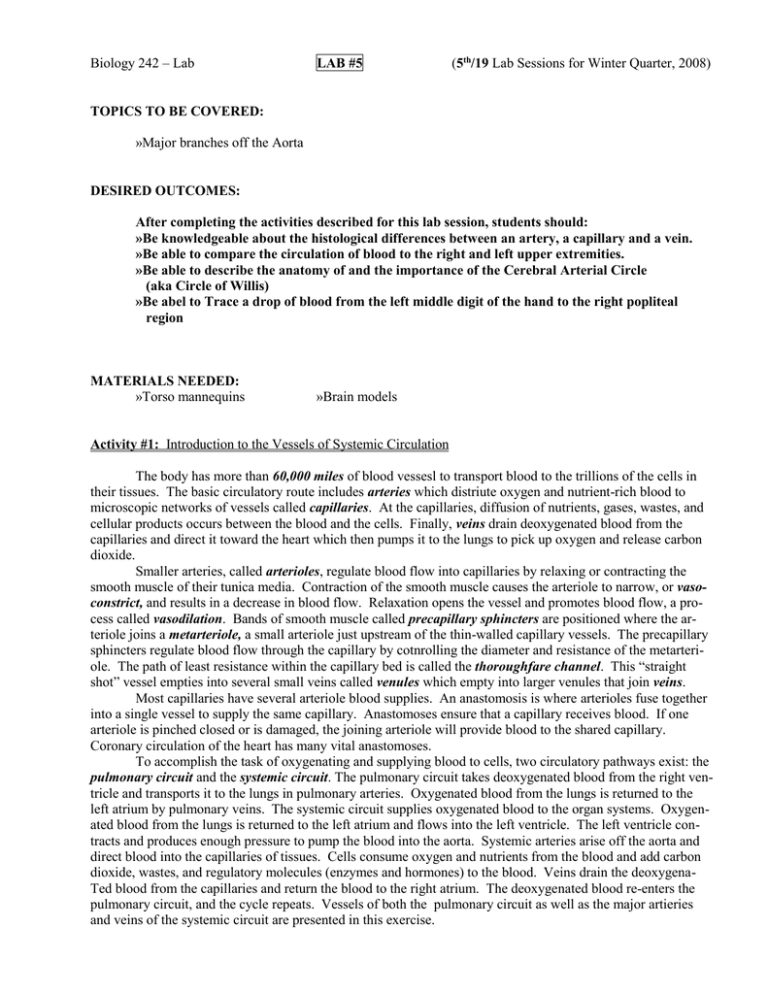Biology 242 – Lab 5 »Major branches off the Aorta
advertisement

Biology 242 – Lab LAB #5 (5th/19 Lab Sessions for Winter Quarter, 2008) TOPICS TO BE COVERED: »Major branches off the Aorta DESIRED OUTCOMES: After completing the activities described for this lab session, students should: »Be knowledgeable about the histological differences between an artery, a capillary and a vein. »Be able to compare the circulation of blood to the right and left upper extremities. »Be able to describe the anatomy of and the importance of the Cerebral Arterial Circle (aka Circle of Willis) »Be abel to Trace a drop of blood from the left middle digit of the hand to the right popliteal region MATERIALS NEEDED: »Torso mannequins »Brain models Activity #1: Introduction to the Vessels of Systemic Circulation The body has more than 60,000 miles of blood vessesl to transport blood to the trillions of the cells in their tissues. The basic circulatory route includes arteries which distriute oxygen and nutrient-rich blood to microscopic networks of vessels called capillaries. At the capillaries, diffusion of nutrients, gases, wastes, and cellular products occurs between the blood and the cells. Finally, veins drain deoxygenated blood from the capillaries and direct it toward the heart which then pumps it to the lungs to pick up oxygen and release carbon dioxide. Smaller arteries, called arterioles, regulate blood flow into capillaries by relaxing or contracting the smooth muscle of their tunica media. Contraction of the smooth muscle causes the arteriole to narrow, or vasoconstrict, and results in a decrease in blood flow. Relaxation opens the vessel and promotes blood flow, a process called vasodilation. Bands of smooth muscle called precapillary sphincters are positioned where the arteriole joins a metarteriole, a small arteriole just upstream of the thin-walled capillary vessels. The precapillary sphincters regulate blood flow through the capillary by cotnrolling the diameter and resistance of the metarteriole. The path of least resistance within the capillary bed is called the thoroughfare channel. This “straight shot” vessel empties into several small veins called venules which empty into larger venules that join veins. Most capillaries have several arteriole blood supplies. An anastomosis is where arterioles fuse together into a single vessel to supply the same capillary. Anastomoses ensure that a capillary receives blood. If one arteriole is pinched closed or is damaged, the joining arteriole will provide blood to the shared capillary. Coronary circulation of the heart has many vital anastomoses. To accomplish the task of oxygenating and supplying blood to cells, two circulatory pathways exist: the pulmonary circuit and the systemic circuit. The pulmonary circuit takes deoxygenated blood from the right ventricle and transports it to the lungs in pulmonary arteries. Oxygenated blood from the lungs is returned to the left atrium by pulmonary veins. The systemic circuit supplies oxygenated blood to the organ systems. Oxygenated blood from the lungs is returned to the left atrium and flows into the left ventricle. The left ventricle contracts and produces enough pressure to pump the blood into the aorta. Systemic arteries arise off the aorta and direct blood into the capillaries of tissues. Cells consume oxygen and nutrients from the blood and add carbon dioxide, wastes, and regulatory molecules (enzymes and hormones) to the blood. Veins drain the deoxygenaTed blood from the capillaries and return the blood to the right atrium. The deoxygenated blood re-enters the pulmonary circuit, and the cycle repeats. Vessels of both the pulmonary circuit as well as the major artieries and veins of the systemic circuit are presented in this exercise. As an added note, blood vessels are a continuous network of pipes, and often there is no anatomical difference between vessels within a region of the body To facilitate identification and discussion of blood vessels, anatomists have named them after an adjacent bone or organ and changed the name of a vessel as it passes into a different region. Artaeries and veins are often parallel and have the same name. For example, the large vessels in the thigh are the femoral artery and femoral vein. As the femoral artery descends the lower extremity, it is called the popliteal artery behind the knee and the posterior tibial artery of the calf. Activity #2: The Arterial System The main artery is the aorta, which receives oxygenated blood from the left ventricle of the heart. Figure ---- illustrates the major vessels of the systemic arterial system. Oxygenated blood is pumped out of the left ventricle of the heart and into the aorta for distribution to the organ systems. Athe aorta is curved like a question mark; it exits the base of the heart, curves upward and to the left, and then descends behind the heart to the abdominal cavity. Arateries that branch off the aortic arch suerve the head, neck, and upper limb. Branches off the abdominal aorta serve the abdominal organs. The abdominal aorta enters the pelvic cavity and divides to send a branch into each lower extremity. Fig--- illustrates the arteries of the chest and upper limb. There are three parts to the aorta: (1) the ascending aorta begins at the base of the heart, where the R and L coronary arteries arise, and extends to the second part; (2) the curved aortic arch off of which arise three major arteries in this order: the brachiocephalic trunk, the left common carotid artery and the left subclavian artery, and (3) the third part, the descending aorta, which begins with a downward turn toward the diaphragm. This third part of the aorta is its longest part, and is itself subdivided into two parts: (a) the descending thoracic aorta, while this portion is in the thorax above the diaphragm, and (b) the descending abdominal aorta once it has pierced through the diaphragm (at the site of the hiatus) and enters the abdominal cavity. The aortic arch has three major arteries serving the head, neck and upper extremities. The first of these, the brachiocephalic trunk, is short and quickly bifurcates into the right common carotid artery and the right subclavian artery. These arteries supply blood to the right side of the head and neck and to the right upper extremities respectively. The left common carotid artery and left subclavian artery originate directly off the aorta. (Only the right common carotid artery and right subclavian artery are derived from a common trunk.) The important vertebral artery branches off each subclavian artery and supplies blood to the brain and spinal cord. Each subclavian artery passes under the clavicle and crosses the axilla (aka armpit) as the axillary artery and continues into the brachia region (aka arm) as the brachial artery. Blood pressure is usually taken at this brachial artery. At the antecubitis, the elbow, the brachial artery divides into the lateral radial artery and the medial ulnar artery, each named after the bone it follows in the forearm. In the palm of the hand, these arteries are interconnnected by the superficial and deep palmar arches which send samll digital arteries to each of the fingers. (In all, except for the brachiocephalic trunk on the right side, the vascular anatomy is symmetri-cal in the right and left upper extremities.) The right and left carotid arteries supply blood to the structures of the neck, face, and brain as shown in Figure----. The right common carotid artery originates off the brachiocephalic trunk, whereas the left common carotid artery branches directly off the peak of the aortic arch. The term “common” suggests that the vessel will quickly bifurcate giving rise to “external” and “internal” branches. Each common carotid artery ascends deep in the neck and divides at the larynx (or level of the angle of the mandible) into an external carotid artery and an internal carotid artery. (The base of the internal carotid artery swells as the carotid sinus and contains baroreceptors to monitor blood pressure.) The external carotid artery remains external to the skull, giving rise to seven branches to supply blood to the structures of the neck and face. The pulse in the external carotid artery can be felt by placing your fingers lateral to your thyroid cartilage. In essence, the external carotid artery supplies all of the external structures of the head. The internal carotid artery enters the boney landmark of the skull called the carotid foramen (and carotid canal) ascending to the base of the brain where it divides into three arteries: (1) an ophthalmic artery – which provides blood to the eyes, (2) an anterior cerebral artery – which supplies blood to the frontal lobe of the brain and (3) a middle cerebral artery – which supplies blood to the parietal and temporal lobes of the brain. The brain has a high metabolic rate anda voracious appetite for oxygen and nutrients. Any reduction in blood flow to the brain may result in permanent damage to the affected area(s). To ensure that the brain receives a continuous supply of blood, branches of the interal carotid artery and other arteries intereconnect or anastomose as the cerbral arterial circle, aka the Circle of Willis. Please refer to Figure --- as this circle is described. The right and left vertebral arteries, which arise off the subclavian arteries, ascend in the transverse foramina of C7 –C1 cervical vertebrae and enter the skull at the foramen magnum. These arteries now fuse into a single basilar artery on the inferior surface of the brain stem. The basilar artery branches into R and L posterior cerebral arteries – which supply blood to the occipital lobes of the brain - and R and L posterior communicating arteries. The posterior communicating arteries form an anastomosis with the internal carotid arteries (just at the site where these bifurcate into anterior and middle cerebral arteries.) One small anterior communicating artery is a site of anastomoses between the R and L anterior cerebral arteries, and this small vessel completes the “ring” of blood vessels at the base of the brain. As the aorta descends through the thorax (as the descending thoracic aorta), twelve pairs of intercostal arteries (aka segmental arteries – because there are twelve vertebral “segments” each with a rib in whose costal groove these segmental arteries lie protected as they course laterally). Now, the descending aorta pierces through the hiatus of the diaphragm and is renamed the descending abdominal aorta. Many arteries stem from the abdominal aorta. An easy way to identify the branches of the abdominal aorta is to distinguish between apird arteries with a right and a left branch and unpaired arteries with a single vessel. There are three unpaird brnaches of the abdominal aorta: (1) the celiac trunk is a short artery arising off the abdominal aorta inferior to the diaphragm. It splits into three arteries: the common hepatic artery, the left gastric artery, and the splenic artery. The common hepatic artery divides to supply blood to the liver, gallbladder, and part of the stomach. The left gastric artery also supports blood flow to the stomach. The splenic artery supplies blood to the spleen, stomach, and pancreas. (2) Immediately inferior to the celiac trunk is the next unpaired artery, the superior mesenteric artery. This vessel supplies blood to the small intestine, parts of the large intestine, and other abdominal organs. (3) The third unpaird artery, the inferior mesenteric artery, originates just before the abdominal aorta divides to enter the pelvic cavity and lower extremities. This artery supplies parts of the large intestine and the recturm. Figure---illustrates these arteries and theorgan sthey supply with blood. There are four pairs of major arteries arising off the abdominal aorta: (1) The suprarenal arteries arise near the superior mesenteric artery and branch within the adrenal glands located on top of the kidneys. (2) The right and left renal arteries, which supply the kidneys, stem off the abdominal aorta just inferior to the suprarenal arteries. (3) A pair of gonadal arteries appear near the inferior mesenteric artery. These arteries bring blood to the reproductive organs of the male and female, and are more appropriately called the testicular arteries in males and the ovarian arteries in females. (4) A pair of lumbar arteries originate near the terminus of the abdomina laorata and service the lower body wall. At the level of the hips, the abdominal aorta divides into the right and left common iliac arteries. These arteries descend through the pelvic cavity and branch into external iliac arteries which exit the pelvis and enter the lower extremities and internal iliac arteries which stay within the pelvis and supply blood to the organs contained there. The external iliac artery pierces the abdominal wall and becomes the femoral artery of the thigh. A deep femoral artery arises to supply deep thigh muscles. The femoral artery passses through the posterior knee as the popliteal artery and divides into the posterior tibial artery and the anterior tibial artery, each supplying blood to the leg. The peroneal artery stems laterally off the posterior tibial artery. The arteries of the leg branch into the foot and anastomose at the dorsal and plantar arches. Activity #3: The Venous System Once you have earned the major systemic arteries, identification of systemic veins is easy because most arteries have a corresponding vein running with them (along with a nerve and lymphatic vessel) in a unit of compartmentalization known as a vascular bundle. This similarity in naming and distribution of arteries and veins is seen when comparing Figures--- and ---. However, there are actually far more veins in the body than arteries, because while all arteries are deep, there are both deep and superficial veins. Unlike arteries, at least the superficial veins are easily seen under the skin. Two additional tips to remember as you study the systemic veins are: (1) that they are ususally painted blue on vascular models and torso mannequins - to indicate that they transport deoxygenated blood (EXCEPT for the pulmonary veins which transport freshly oxygenated blood…and prenatally, except for the umbilical vein which transports oxygenated blood). Thus, when identifying veins, always work in the direction of blood flow: from the periphery toward the heart. (2) Veins DO NOT BRANCH…rather they “join” or “merge into” other veins. That is, smaller veins join larger veins which merge into even larger veins, etc. So, be mindful of your terminology when describing venous blood flow. The internal jugular vein, which exits the skull via the jugular foramen, descends the neck, and empties into the brachiocephalic vein. Superficial veins that drain the face and scalp empty into the external jugular vein which also descends the neck to join the brachiocephalic vein. The right and left brachiocephalic veins merge at the superior vena cava and empty deoxygenated blood into the right atrium of the heart. (Now, blood in the right atrium enters the right ventricle, which contracts and pumps it to the lungs through the pulmonary circuit.) Figure--- illustrates the venous draininge of the upper extremity, chest, and abdomen. The hand drains into digital veins which empty into a network of palmar venous arches. These vessels drain into the cephalic vein which ascends along the lateral margin of the forearm and arm. The median antebrachial vein ascends to the elbow, is joined by the median cubital vein which crosses over from the cephalic vein, and becomes the basilic vein. (The median cubital vein is often used to collect blood samples from an individual.) Also in the forearm are the radial and ulnar veins which fuse above the elbow into the brachial vein. The brachial and basilic veins meet at the armpit as the axillary vein, which joins the cephalic vein and becomes the subclavian vein. Subclavian veins and veins from the neck and head drain into the brachiocephalic vein which then empties into the superior vena cava. (Note: Although there is only one brachiocephalic trunk (artery), the brachiocephalic veins are bilateral: there is both a right brachiocephalic vein and a left brachiocephalic vein. The left brachiocephalic vein is longer than the right brachiocephalic vein, because vessels on the left side of the midline have farther to travel to reach the superior vena cava which lies to the right of the midline.) The superior vena cava returns deoxygenated blood from all the structures superior to the diaphragm: the head, neck, both upper extremities, and the thorax.





